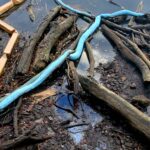Fingertips tore off large flakes of salt that had accumulated on a waterproof sensor attached to a surfboard. The mounting bracket is carefully adjusted to ensure an accurate temperature reading.
In addition to navigating changing waves, you’ve collected valuable sea surface data that will be crucial to helping researchers understand historical ocean temperatures.
It is usually difficult to imagine how a member of the public fits into a big-budget research project conducted by qualified scientists with years of education and experience. Through citizen science – the process of collaborating with non-traditional volunteer participants who contribute to scientific research – collaborations between traditional scientists and community members have gained popularity and helped answer important scientific questions.
Citizen science has expanded into areas of environmental and computer science where technology, funds, and resources alone are not sufficient to achieve research goals. And University of Miami graduate students can learn more about the topic by taking the course Introduction to Citizen Science.
Taught by Keene Haywood at the Marine Campus in Virginia Key, the course was developed 10 years ago as part of the Exploration Science track of the Master of Professional Science (MPS) program. Haywood noticed that citizen science was becoming increasingly common and growing into a formalized academic discipline, with great potential for interfacing with the public.
“Citizen science is also the site of many exciting discoveries and explorations. I thought it would be helpful for students in our program to have some formal training on how citizen science projects work and how to develop them,” said Haywood, senior lecturer and science curriculum coordinator at MPS exploration.
The course objectives go beyond knowing how citizen science is used.
“The goals of the course are for students to develop a deeper appreciation of what citizen science is and, more importantly, for them to develop the skills necessary to design, plan and manage a citizen science project so that they can potentially be leaders in these efforts rather than just being a participant,” he added.
The course has two main tasks: an annotated bibliography, in which students delve deeper into topics related to citizen science, and a final group project that brings students together to create a conceptual citizen science project. Former students used the final project structure as a guide to creating their own start-up.
Weekly lectures explain how to implement a citizen science project, maintain healthy relationships between participants and researchers, and the benefits associated with participant data, such as reduced costs and highly scalable data. The lectures also discuss how to address the shortcomings of citizen science, such as volunteer credibility and costs associated with marketing and participant retention.
Several guest speakers who have developed or worked on citizen science projects are invited throughout the semester to share first-hand accounts of their experience.
Anna Bakker, the most recent guest speaker, summarized her role as a data intern working for the Coastal Observation and Seabird Survey Team (COASST) from 2015 to 2017. COASST is a program of citizen science that works closely with volunteers along the Pacific Coast, from California to Alaska, who help monitor seabird populations. Developed in 1999, COASST has an average of 1,000 volunteers per month surveying 450 beaches along the U.S. West Coast.
Volunteers are trained on how to conduct a beach survey, use a bird identification booklet and complete basic measurements. The purpose of the data collected by COASST volunteers is to create environmental status reports for governments, non-governmental organizations, tribal communities, and other interested groups. Bakker highlighted the growth she has witnessed through volunteers throughout her time at COASST.
“I noticed that the volunteers sometimes took a while to understand how to do a survey, but after going to the beach month after month (and especially after bringing their friends or dogs with them), they became more enthusiastic about it. idea of searching for stranded seabirds. ,” she says.
The growth of citizen science suggests that years of schooling, formal laboratory training, and technical certifications are no longer the only requirements for participating in innovative research. The public’s role in scientific research continues to support continued data collection, reduced research costs, and increased public awareness of scientific topics.
Researchers have also increased the number of volunteers through a concept known as gamification, in which participants collect valuable data through processes that mimic reward systems found in video games.
There are various platforms for interested people to get started with citizen science, including Save a reef at the Rosenstiel School of Marine, Atmospheric and Earth Sciences. Rescue a Reef brings together researchers, students and community members to participate in coral research and restoration.
Another option, iNaturalist, is a citizen science platform designed to help people identify plant and animal species. And Zoouniverse hosts a wide range of citizen science projects for everyone to explore and get involved with.











